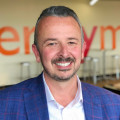Healthcare Must Move Beyond Fax Machines to Survive COVID-19
My wife saw her physician for a routine checkup recently, which isn’t particularly noteworthy — except that it started with a call from a nurse to collect her vitals. After her vitals, my wife also didn’t wait “in line” from her provider’s waiting room to see her physician. She waited online, from our couch.

A few short months ago, a virtual visit like this was rare. But in the wake of COVID-19, what was once remarkable is now normal. Indeed, one healthcare company reported telemedicine visits were up 5,525 percent in March compared to February.https://khn.org/news/coronavirus-fuels-explosive-growth-in-telehealth-%e2%80%95-and-concern-about-fraud/ In my nearly 20 years in the healthcare industry, I’ve never seen anything like it.
Within 30 days, a decade of movement swept through our industry. Every player in our system was affected. That momentum pushed us past old concerns over nascent technologies and into a world remade by necessity.
We’ve found new ways to care for patients when our nurses and doctors can’t be with them in person. We’ve shared data with each other in ways previously resisted. And we’ve united around a common cause: we’re in this together.
We’ve come so far, in part, because we had so far to go. This pandemic has shown us exactly how outdated the industry has been—as one recent New York Times articlehttps://www.nytimes.com/2020/07/13/upshot/coronavirus-response-fax-machines.html called out, our country is “running into problems caused by its fragmented health system, a jumble of old and new technology.” It’s clear none of us want to go back to the way things were. So how do we carry this momentum with us when so much work still needs to be done and so many challenges still await?
In broad strokes, we know we have to more fully embrace technology and stop relying, in many cases, almost solely on archaic services like fax machines. We know we can’t be paralyzed when presented with change, and that we must be resilient. Most of all, we now have insight into where we’re going and how to get there.
Already we’ve seen the industry shift its services to virtual settings and prioritized those most in need of care. The coming challenges demand these efficiencies and more, as many of those who delayed elective procedures and surgeries look for care once again. This pent-up demand for care must be met by efficient and patient-focused methods to move patients through the system.
A second peak may come, and though its wave has yet to crest, it’s lapping at our shores. Tens of millions of Americans are recently unemployed, and many of them are without employer-sponsored healthcare.
The consumerism trend that began in 2006 with the Medicare For All Act is about to intensify. And as it is with any consumer, cost is king, followed by quality and convenience. Already we’re starting to see affordability and access challenges caused by economic pressures and loss of coverage. According to the 2020 Medication Access Report, 30 percent of providers surveyed in May 2020 said their patients are unable to pay for prescriptions.https://www.covermymeds.com/main/medication-access-report/coronavirus-update/ The same report found 20 percent of patients have used a cash price program to help afford their medication.https://www.covermymeds.com/main/medication-access-report/coronavirus-update/
We must continue to meet patients’ needs too — whether it’s home delivery of prescription medications or more efficient patient workflows. With so many vulnerable among us, we simply need to empower patients with more choices for prescriptions and other types of care.
Over the coming months — as people search for their center, for their new normal — I want to encourage us to come together in our quest for solutions. And as we look to the future, I hope we can take the lessons we’ve learned with us.
Our path forward will require tremendous focus on what needs done. There are big challenges before us, and the industry must work together as a collective to continue helping patients, especially those who are most vulnerable.
And most importantly, we can’t lose the emotional and human touches so many of us have reclaimed in recent weeks. Within my own family, we’ve vowed to continue with re-established routines, like nightly dinners and family time.
As a healthcare family, can we do the same? Can we find new routines amid chaos while also carrying forward the human connection that inspired so many to join this industry?
I strongly believe moments like this — of great, generational challenges — are like looking in a mirror. We uncover clear and accurate answers to stark and pressing questions about who we are. But we also are presented with the opportunity to decide who we’ll become, and it is this thought that excites me most.
I’ve seen the best of our industry, and I know that even in our tattered capes, together we can rise above so many of the challenges that face us. And in doing so, we can help redefine healthcare for the remarkable now and shape the lives of generations to come.
The latest healthcare insights, floated right to your inbox.





